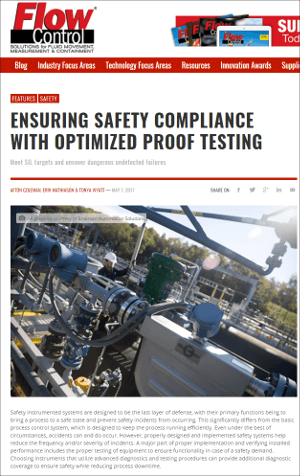If you are new to the world of process safety, you quickly learn that it has its own jargon with phrases such as safety instrumented functions, proof test intervals, PDFavg, etc.
A Flow Control magazine article, Ensuring safety compliance with optimized proof testing, written by Emerson’s Afton Coleman, Erik Mathiason and Tonya Wyatt does a great job of introducing and explaining these concepts.They open describing the importance of testing the components within a safety system:
A major part of proper implementation and verifying installed performance includes the proper testing of equipment to ensure functionality in case of a safety demand.
They define the components of a safety instrumented function, also known as a safety loop, as having:
…logic solver, sensor(s) and final element(s)…
Probability of failure on demand (PFD):
…describes the risk of a safety instrumented system component being in a failure mode when it is also required to bring the process to a safe state. The case that a safety demand occurs simultaneously with a component failure can have dangerous results because it prevents the safety instrumented system from mitigating the hazardous event…
The exida website further defines PFDavg:
PFD can be determined as an average probability or maximum probability over a time period. IEC 61508/61511 and ISA 84.01 use PFDavg as the system metric upon which the SIL [safety integrity level] is defined.
And proof tests:
…are operational tests conducted in accordance with an individual product’s safety manual that test the component’s ability to perform its safety function and uncover dangerous undetected failure modes. Dangerous undetected failures are failures that prevent the device from performing its primary function and remain undetected by the device during normal operation.
A proof test interval is the time between these tests being performed. Testing components such as whether a safety valve’s seat leaks may require a process shutdown and removal from service to perform. Afton, Erik and Tonya describe how to optimize proof test intervals by:
…utilizing different proof test options as provided by the manufacturer, proof tests utilizing automatic diagnostics, as well as supplementing proof tests with additional in-service or in-situ tests, such as a final element partial stroke test.
They give an example of different levels of proof testing a Coriolis flow meter. The first test with the meter still inline checks transmitter output, alarms and configuration. This test level has 50-60% effectiveness in uncovering dangerous undetected failure modes. Adding advanced diagnostics like smart meter verification that checks the sensor and electronics increases effectiveness into the 90% range when combined with the first proof test level. This testing is also performed with the meter still in line.
Finally, by combining the first level of proof testing and taking the Coriolis meter out of the line to perform a full calibration against a standard increases the effectiveness to around 99%.
Read the article for other methods of optimizing proof test intervals such as partial stroke testing on valves used in safety instrumented functions and the benefits achieved from being able to extend these time intervals between tests.
You can connect and interact with other process safety experts in the Safety Instrumented Systems group in the Emerson Exchange 365 community.








